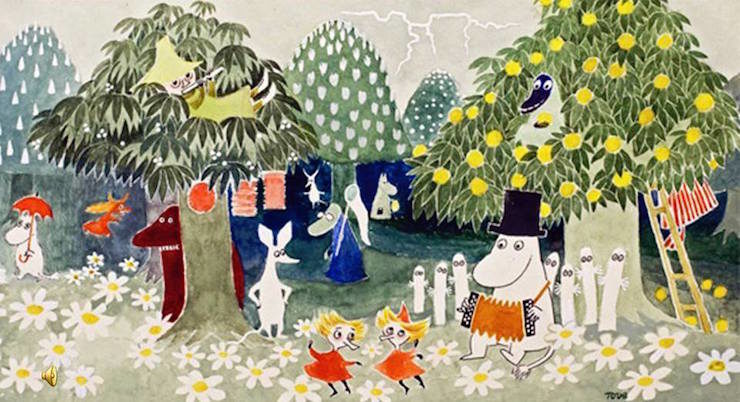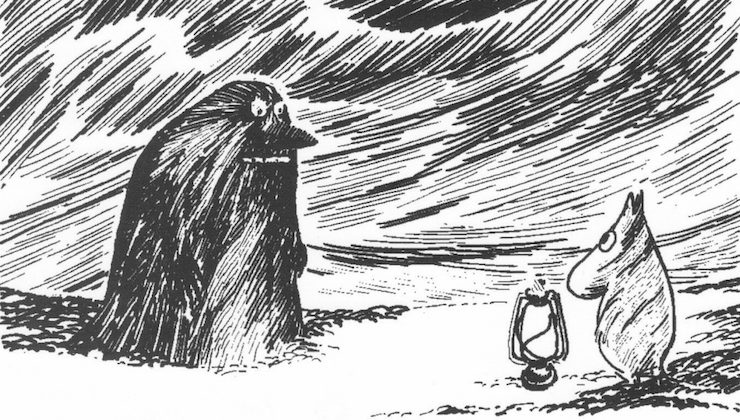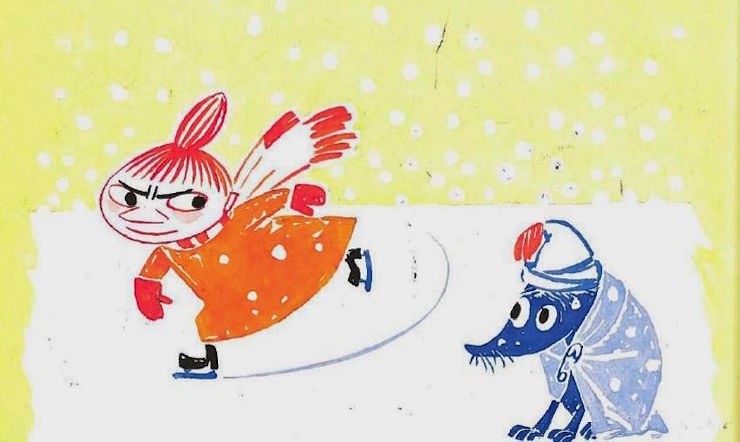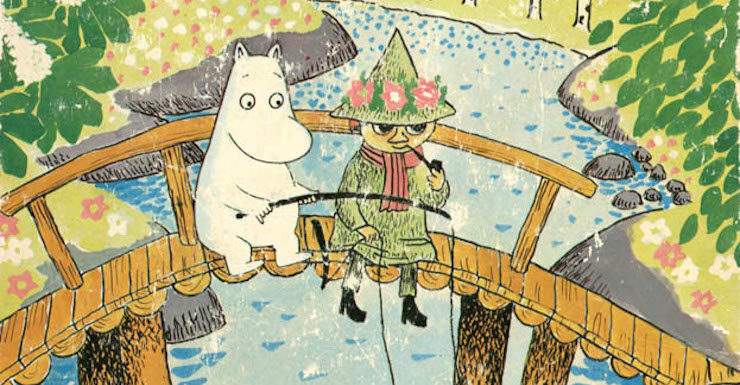Tove Jansson’s books are full of what self-help books call “life lessons.” But the lessons, such as they are, are so artfully embedded in her spare, elegant novels and in her charming melancholy children’s stories, that you might miss them if you aren’t on the lookout. What’s more, Jansson wasn’t interested in soothing us or in tidying the messy corners of our minds. She was after something else: the lesser-appreciated virtues of complication, paradox—the dappled things that turn life from a chore to a work of art.
What follows are some of Jansson’s teachings, drawn freely from across her Moomin comic strips and books, as well as from the novels written with adults in mind.
How to Play

Tove Jansson’s adults are as devoted to imaginative play as her children—if anything, they’re more jealous of their right to it. A portion of the small island in the Finnish Archipelago on which the family in The Summer Book spends its summers is known as “the magic forest.” It’s been decorated with wild branches, twisted driftwood, and the like. But, with the absolute assurance common to Jansson’s artists (acknowledged and unacknowledged), the Grandmother knows that the forest isn’t right. She takes to spending her days carving wood spirits into logs and boughs. When her granddaughter Sophia discovers that the old woman hasn’t been dozing in the sun all these weeks as had been supposed, she asks what her grandmother’s been up to. The answer: “I’m playing.”
In Fair Play, Jonna gives a fiercer explanation of her activities. When Mari finds her carving a wooden box, she wonders if Jonna has always worked in wood, as she puts it, “for real.” Jonna is not pleased with the turn of phrase: “‘For real…That’s brilliant. Try to understand, I’m playing and I mean to go on playing.” Later she directs Mari not to mourn the loss of a fishing net made by her uncle when he was ninety. The net is immaterial, her uncle’s joy in making it was the thing that counted: “He was at peace, doing work that was his and only his. You know I’m right. He didn’t have any goals any more.”
Even Moominmama, generally so practical and self-sacrificing, defends her right to “play,”—i.e. collect firewood—in Mominpappa at Sea. A few pages later, she’s discovering the pleasure of sawing wood, and just a bit after that, she finds out that she can really paint and creates a mural on the walls of Moominpappa’s lighthouse.
How to Love What is Difficult
“How to love what is difficult” could be a subtitle to Jansson’s novel Fair Play, really a series of sketches about the relationship between Jonna and Mari, two Finnish artists. In lieu of summarizing that book in its entirely, here’s an illustration of the theme from The Summer Book: Sophia’s cat, Ma Petite (called Moppy) is aloof, stubborn, a murderer of rats (well done!) and birds (oh you monster!). Dismayed by his coldness and criminal behavior, Sophia trades Moppy for Fluff, a purring, loving “submissive” creature. But Fluff can’t be bothered to move himself from a comfortable spot, not even when a storm is on the way. “It’s funny about me” says Sophia, “I think nice weather gets to be boring.” So back comes Moppy.
How Not to Be Alone

Jansson was a great writer of old age. Was it because she turned to fiction for adults later in life? It’s clear that she felt an affinity to the old as well as to the young. (Though it’s often assumed that protagonists of The Summer Book are straightforward depictions of the author’s mother and niece, a case could be made that they are both reflections of herself.) Old age and solitude are frequently linked in these stories. Take, for example, the old woman who lives alone on a very small island in “The Squirrel” (A Winter Book). Her days are filled with household chores, periods of frustrated at writing, and doses of Madeira administered according to an increasingly relaxed schedule. Ambivalent in her isolation, she hides from a boatload of visitors, only to be bitterly disappointed that they don’t, in the end, land. When a lone squirrel washes up on her island, she finds herself obsessed. There is a desperation to the attention she pays to this small, wild creature; her attempts at caring for it are frenzied, nearly mad. She writes nasty things about the squirrel, rips up the pages. At last the squirrel, with wild cunning, manages to untie the woman’s boat and float away from the island. The old woman is liberated as well—liberated from her last connection with the world.
Anna Amelin lives in self-imposed isolation in The True Deceiver. She is a children’s book illustrator who rarely leaves her large house and has almost no interaction with the other residents of her small fishing village. Her life is her art, but her art is compromised by the demands of the marketplace. She doesn’t appear to mind compromise, as long as she can paint the nature scenes she lives for. Though Anna believes herself creatively fulfilled, she experiences only a fraction of life; her solitude fosters an ignorance of life that verges on dishonesty.
And you can’t talk about loneliness and Tove Jansson without mentioning the fearsome Groke. The Wikipedia description of the Groke is charming: “She appears as a ghostlike hill-shaped body with two cold staring eyes and a wide row of white shiny teeth.” The Gorke has not chosen isolation, but cannot avoid it: wherever she goes, the ground freezes under her and she kills whatever she encounters, her voice is a haunting howl. She’s mentioned only in tones of horror in Moominland, though several characters (including Moomintroll) are perversely fascinated by her.
How to Be Alone
In contrast to this parade of sad, lonely old ladies, there is Mari. In the final episode of Fair Play, “The Letter”, Jonna finds out that’s been given use of a studio in Paris for a year. She can’t turn it down and she can’t accept it—acceptance means a year’s separation from Mari. But when Mari finds out, she’s not worried, she finds herself not angry or scared, but oddly excited:
She began to anticipate a solitude of her own, peaceful and full of possibility. She felt something close to exhilaration, of a kind that people can permit themselves when they are blessed with love.
For the very young narrator of “Snow,” in Jansson’s autobiographical Sculptor’s Daughter, separation from the world is an opportunity to have her mother all to herself. Mother and daughter are snowed in in a cabin in the woods, and for them it’s a vacation from the requirements of daily life that even the most bohemian of families must observe:
We walked around in our nighties and did nothing…We were like bears with pine needles in our stomachs and anyone who dared come near our winter lair was torn to pieces. We were lavis with the wood, and threw log after log on to the fire…Sometimes we growled. We let the dangerous world outside look after itself.
How to Let it Out

Little My, a being so small that Jansson had to illustrate her through a magnifying glass in order to render her visible to the human eye, is, from the moment of her birth astonishingly self possessed. She makes no excuses, no matter her behavior. You might find Little My a trial to spend time with, but she really doesn’t care what you think, she is pure Id and delighted with herself.
Remarkably, Little My is not only in touch with her anger, but aware of its power to liberate:
“If you’re sore you’re sore,” observed Little My, peeling her potatoes with her teeth. “You have to be angry sometimes. Every Little Creep has a right to be angry. But [Moominpapa’s] angry in the wrong way. He’s not letting it out, just shutting it up inside him.” (Moominpapa at Sea)
It should come as no surprise that Little My is one of the most contented creatures in Moominland.
How to Get Over It
If a good tantrum doesn’t set things right, a good deed might. The little girl in The Sculptor’s Daughter is jealous of her father’s pets, particularly his small monkey Poppolino. An invalid left alone while the two go out, she tears around her father’s studio, smashing plaster casts and breathing her germs all over the monkey’s cage. Calmed somewhat, she gets back in bed and decides that the pot holder she’s been crocheting will be a tiny sweater for her nemesis.
The Summer Book’s Sophia gets over an “irrational terror” of small animals and insects by paying them close attention. In fact, at her grandmother’s suggestion, she begins writing a book about angleworms, daddy longlegs, and “Other Pitiful Animals.” Sample text:
Small animals are a great problem. I wish God had never created small animals, or else that He’d given them better faces
And finally, Jansson is a full-blown supporter of that old saw “looking on the bright side.” In her introduction to A Winter Book, Ali Smith describes Jansson’s “fine tight-roped balance of hope and hopelessness. The stories face age, youth, and each of the dark and light seasons with the same determination to make something light of it all.” Finding his sculptures smashed, the father in The Sculptor’s Daughter remarks that they weren’t any good anyway. A dead cat, “if she lived to be seventeen was probably quite tired and no longer very well” (in the story “Letters from Klara”). Jonna isn’t disappointed that she’s grown too old to lift her boat out of the water, she observes how it makes her see the world fresh: “it was quite interesting…it gave me ideas, you know—completely new ideas. About lifting, leverage, balance, angles of fall, about trying to use logic.”
The last chapter of Alain de Botton’s book How Proust Can Change Your Life—to which this post is of course indebted—is called “How to Put Down Books.” With all due respect to Mssrs Proust and de Botton, they’re wrong. With Jansson’s oeuvre available to English-language readers as it never has been before, surely the time has come to pick up her books, and to appreciate, as so many have around the world, all that it can teach us.
All art by Tove Jansson.
This article was originally published in April 2010 as part of our series celebrating the 65th anniversary of Tove Jansson’s Moomins.










